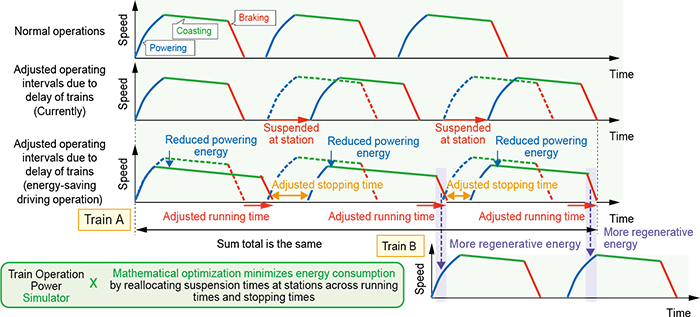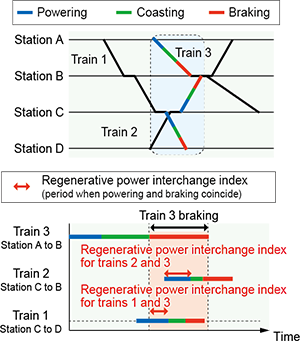24. Energy-saving driving operation to minimize the energy consumption during small scale delays
In the event of a small scale delay lasting a few minutes, trains are sometimes required to be suspended at stations. The aim is to prevent spikes in passenger numbers and also to avoid having trains slow down or come to a stop between stations. When a train proceeds slowly to the next station (instead of stopping at the previous station), we can reduce powering energy (see Figure 1). Meanwhile, by adjusting the suspension time at stations and coordinating the timing of powering and braking by the affected trains, we can increase regenerative energy (see Figure 1). To date, we have not been able to reconcile these two seemingly conflicting objectives. But our proposed energy-saving driving operation uses mathematical optimization and simulation to achieve both objectives simultaneously. We begin by defining the regenerative power interchange index, the potential for regenerative power interchange during periods when powering and braking coincide for two separate trains (see Figure 2). We then use an existing Train Operation Power Simulator to calculate, for each train in turn, how travel time between stations affects powering energy. Mathematical optimization tries to minimize the difference between total powering energy and the sum of the regenerative power interchange indices multiplied by the coefficient W. A larger W value indicates higher priority to regenerative power interchange.
We analyzed the train timetable over a period of one hour following a small scale delay, which includes the time taken to restore normal operations. We looked at two scenarios: trains suspended at stations, with no consideration of energy consumption; and using our optimization approach. The analysis found that both powering and regenerative energy increased in line with the W value (see Figure 3), and that the optimized energy-saving driving operation delivers energy savings of around 2% (see Figure 4). The energy-saving driving operation is readily incorporated into automatic train operation systems because it updates train arrival and departure times, and speed profiles in real time. It can also be used to build energy-saving considerations into timetable planning.
Other Contents
- 22. High-efficiency generator design for diesel electric cars
- 23. Driver advisory system for long-distance trains by speed transition estimation
- 24. Energy-saving driving operation to minimize the energy consumption during small scale delays
- 25. Modular sound insulating barriers designed to replace existing noise barriers on viaducts
- 26. Reducing aerodynamic noise and pressure fluctuation from bogies on high-speed trains
- 22. High-efficiency generator design for diesel electric cars
- 23. Driver advisory system for long-distance trains by speed transition estimation
- 24. Energy-saving driving operation to minimize the energy consumption during small scale delays
- 25. Modular sound insulating barriers designed to replace existing noise barriers on viaducts
- 26. Reducing aerodynamic noise and pressure fluctuation from bogies on high-speed trains




